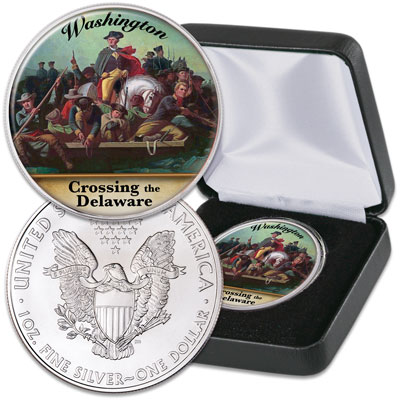The Man, The Money
During his lifetime, George Washington turned down all attempts to honor him on U.S. currency of any kind, including a refusal to have his portrait struck on the first U.S. silver dollar. Today, Washington, as a collecting category, is a superstar.
A recent Heads & Tails article looked at the perennially popular image of Washington crossing the Delaware River on Christmas night 1776. But even further back, the man who did not want to be commemorated on circulating American currency made his inaugural appearance on paper money. What changed?
At the start…
Liberating themselves from a kingdom whose monarchs appeared on its coinage, the Founding Fathers were against that practice. Never mind that Roman emperors did it, and the Roman rules of governance provided the model for our fledgling country. It was unpatriotic to have living leaders’ portraits on circulating coins!

That new tradition remained until well into the 19th century. Then the Civil War occurred. When it ended in 1865, there was a desire to re-establish an undivided union and rebuild the national economy. American money needed a refresh. In 1866, Congress passed an act that, among other stipulations, stated no living person could be portrayed on coins or paper money.
Our nation’s first president had died in 1799. So, 70 years later, the unfinished Gilbert Stuart painting of Washington’s head and shoulders rolled off the Bureau of Engraving and Printing presses. Where? On the fronts of the Series 1869 $1 United States Notes. And thus was born a new category for numismatists!
If you’re new to building a collection of paper money, you might want to visit Littleton’s Learn Center to discover more about notaphily’s evolution. You also might enjoy reading about the nuances of paper money in this Heads & Tails article.
Ways to collect Washington
Those initial dollar bills were legal tender notes and large! Nicknamed “horseblankets”, they measured 7 3/8 x 3 1/8 inches, a noticeable difference when compared with the more economically sized modern notes that are 6 1⁄8 × 2 5⁄8 inches. The last large-size $1 note ever issued has Washington’s portrait on the front and is a must-have for new collectors.
Some paper money collectors also look for this note, and others like it, because of the distinctive designs on theirs backs. The 1923 note mentioned above is also referred to as a “cogwheel” because of its resemblance to a gear at its center. It was part of the note’s overall design to foil counterfeiters. Collectors bestowed a separate nickname to these elaborate designs that carry Washington’s portrait on their fronts – “funnybacks.” This Heads & Tails article traces how that might have come about in the competitive world of bank note designers.
It’s fitting that General George Washington is on collectible dollar bills from WWII. Known as Emergency Notes, they were issued with different colored Treasury seals. This 1935A $1 Silver Certificate with the yellow seal to the right of Washington’s portrait was part of the U.S. campaign in North Africa called Operation Torch. The ones with a brown seal were printed for use in the Pacific Theater.
You don’t have to be a baby boomer to collect Washington on paper money in post-WWII peacetime. Here he is on the sought-after 1957 $1 Silver Certificate. Once redeemable for silver coin or bullion on demand, these notes and the redemption option were discontinued by an act of Congress in 1963. It can be yours when you join Littleton’s American Paper Money Club.
Or if you’re already collecting small-size U.S. paper money, this handy checklist can help you keep track of what you have and what you’re looking for. And if you’re “all George, all the time,” check out this nifty George Washington Tribute Set!
If European queens, why not a First Lady?
From Maria Theresa, Empress of the Holy Roman Empire, to Queens Victoria and Elizabeth of Great Britain, women have appeared on a country’s circulating coins. It’s reasonable, then, to ask: If President George Washington can be honored on paper money, why not the first First Lady, Martha Washington?
 Martha Washington
Martha WashingtonTurns out she was!
To date, she’s the only real female to appear on U.S. paper money. The $1 Silver Certificate that bears her portrait was printed in 1886, six years after her husband’s legal tender note. But before and after, any woman appearing on American paper money has been the allegorical figure. Her presence reflected the aspirational nature of a post-Revolutionary America.
According to the Bureau of Engraving and Printing, the $1 note that has featured George Washington’s portrait since 1869 now makes up about 45% of all paper money production. As you can see by the opportunities in this article, there’s no shortage of ways to build a collection honoring the Father of our Country!


 2021 Colorized Washington Crossing the Delaware Silver American Eagle
2021 Colorized Washington Crossing the Delaware Silver American Eagle George Washington Tribute Set
George Washington Tribute Set
